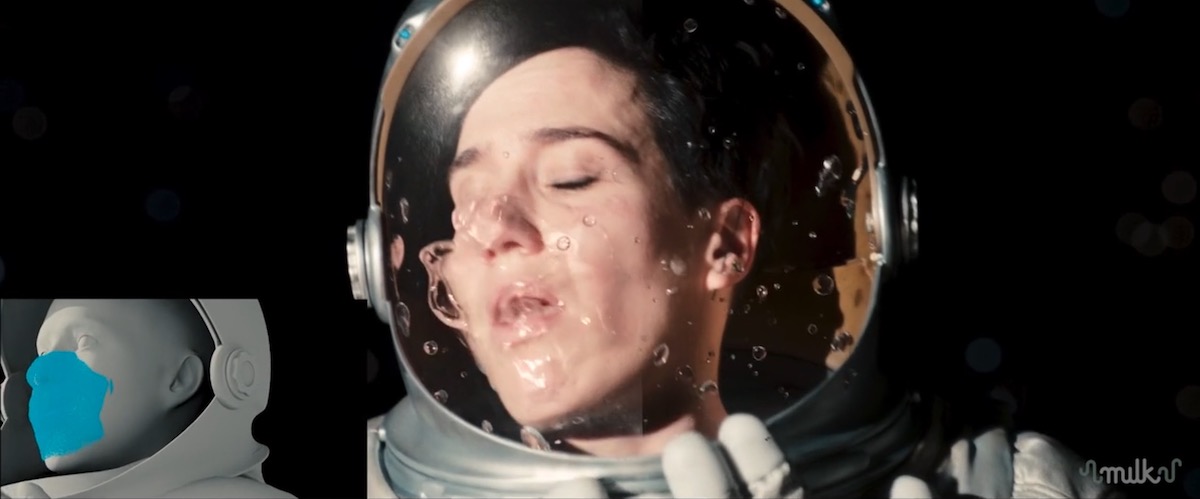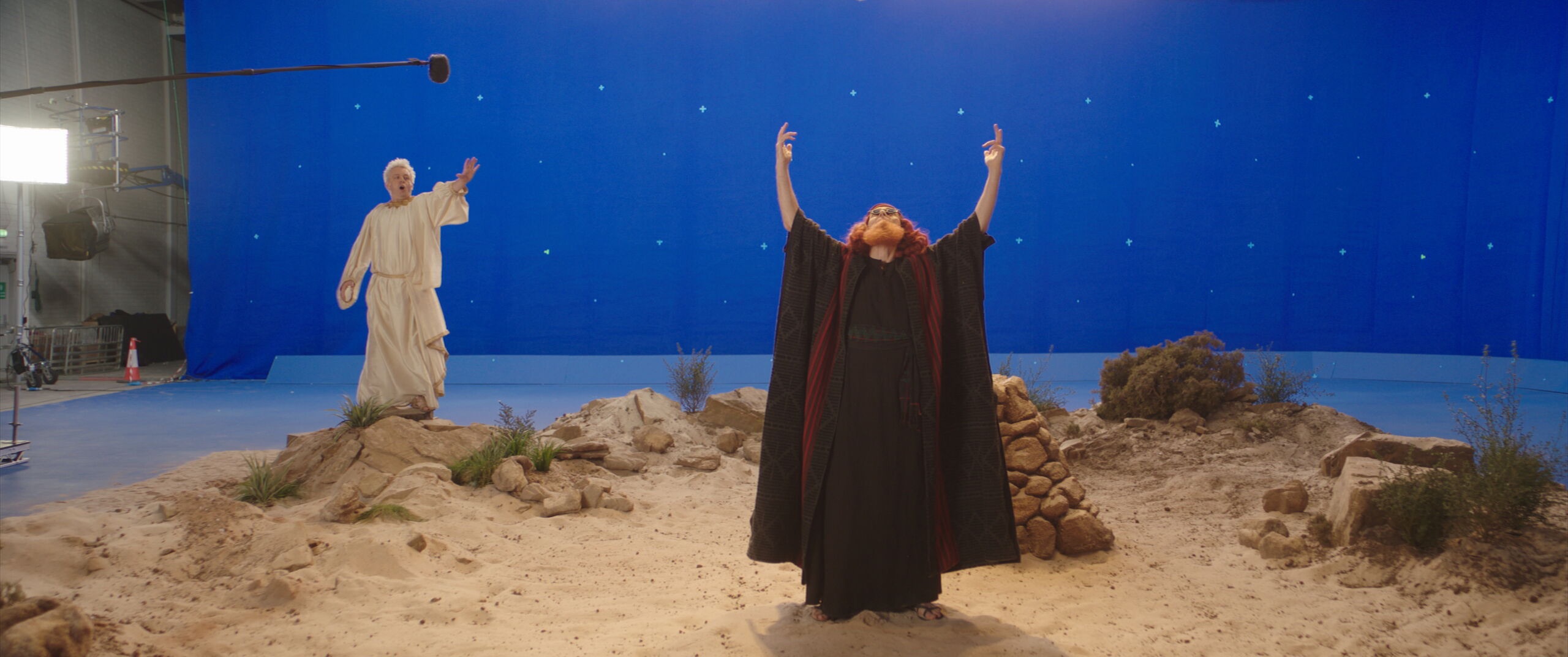Crew-members describe their roles in making the sequence possible.
Episode 8 of the Sky One sci-fi series Intergalactic features a space walk sequence in which water bubbles fill one of the character’s helmet. The drowning moment required several crucial visual effects—extensions of the spaceship, the wider space environment and, of course, the water bubbles themselves.
Members of the team behind the work at Milk VFX share with befores & afters how this particular moment was achieved, from modeling to tracking and matchmove, through to animation, effects sims and lighting.


Setting up the scene
Jean-Claude Deguara, production visual effects supervisor: Here, they’re having problems on the ship and someone needs to go up on the outside of the ship to fix the problem. While they’re on the outside doing the spacewalk there’s a malfunction that causes water to break into the suit. And in zero gravity, water loose in a spacesuit can be one of the most dangerous things that you could get, because of where it could travel. There’s a slow build-up where the water covers her mouth and it starts to choke her. It is an incredibly tense five minutes of action.
Matias Derkacz, head of 2D and in-house VFX supervisor: We knew from the very beginning that it was not about doing visual effects in the ‘usual’ way – making an explosion or something obviously visually impressive – this was about enhancing her performance. From being on set and discussing with the director, China Moo-Young, on the day, she was always really emphasising the fact that we know it’s about her drowning. And directing and giving advice on the day of how we do that without having any of the water, it becomes quite challenging.


Assets and prep for the drowning scene
Sam Lucas, head of modelling: First we had the main ship – the ‘Hemlock’ – that appears throughout the series. For this spacewalk, we gave production the set dimensions so they could build part of it to match the ship that we had built. Then, the character’s visor was CG, and she had CG tools around her waist which float up. We built a digi-double for her, but it was only for matchmove and for FX, not rendered. We also built and textured a hero detailed patch of the top of the Hemlock.
Amy Felce, head of tracking and matchmove: We had a nice model of the helmet. We were able to track around the edge of the helmet on the plates and then line up the visor that was in the rig. Obviously there’s some shots where she turns sideways and she moves her head around quite a lot, so when the visor turned sideways it was quite difficult to keep the dome of the visor looking like it was going at the right depth. But having the rig and the whole helmet in there was really useful for that.
We also had to matchmove her face inside, because there’s the interactions of the face with the bubbles, and we needed that for the reflections for the visor as well. Actually, we ended up matchmoving her facial expressions behind the visor as well, so anything her mouth, and nose, and her eyes were doing. That also went on to help animation create some rough bubble animation that would then go on to FX as well so they could have it interacting with the shapes of her face.
There’s those tools that were floating up off her suit, which obviously aren’t floating in the plates. So we ended up doing full roto-anim of her in her whole suit so that animation could then pin the tools to float around, also for other shadow interactions. And there was also a few things like flashing lights on her backpack so we had to matchmove her whole body in the end and her face, and do facial animation at the same time. It was quite an involved one tracking-wise.


Lighting and rendering considerations
Adrian Williams, head of lighting: Here we had a one-directional light and some low ambience to really capture that space kind of vibe. But one of the things that was a bit challenging was, again, trying to make the glass look believable. So we got a texture artist to go through with loads of different smudges, textures, scuffs, scratches, all that kind of thing. I think one of the main things was trying to get the detail across was the micro scratches inside the visor.
So with that, in the lookdev process, we had to do a lot of testing just to make sure we got the right amount of scratches, how big they were, how small they were. And one of the things that was quite important to the client was to get that kind of ‘blue’ feel. So we ended up doing a few passes that we supplied to comp that gave comp a lot of power, to control, to dial in the certain areas of the animated evaporation on the visor, the dust, the scratches.
Water in space
Jean-Claude Deguara, production visual effects supervisor: When we were discussing the script with the director, China, and the show runner, Julie Gearey, and the producer, Iona Vrolyk, we found there’s some really nice footage of an astronaut on a space station who’s wringing out a flannel.
Dimitris Lekanis, head of FX: It’s the one with the Canadian astronaut who is actually testing, how does water look in zero gravity? How does it actually feel on the skin? And how does it keep the cohesion, and the adhesion, and other kind of behaviours?
Neil Roche, head of 3D: From an animation point of view, after Amy had done the tracks we set up a little bubble rig that would stick to the actor’s face. It was a guide for Dimitris for his FX work. But I think the problem for us was how do we show this to the client without scaring them and showing them gray scale animation only? Because they wouldn’t be able to comprehend what we were trying to do. So we had to do a rough animation of this bubble going up her face to then give to the FX team. And then the animators also had extra bubbles inside her helmet.
It was just about keeping enough of her performance in there so you can still read her face without completely obscuring her with the bubbles. We did one pass of animation to give the director an idea about what we were trying to do. And then it was passed over to the FX team to carry on with that.
Dimitris Lekanis, head of FX: We broke down the setup on the basis of starting from the simplest and then reaching a point that we can actually create a simulation model that keeps consistency and keeps the look very, very similar to what we want. Then on top we added the extra performance from the actor, like the opening and closing of the mouth and the movement of the bubbles.
We used Houdini to simulate the water. For the surface tension of the water we used the solver in Houdini which was pretty good for the cohesion part, which makes the water become spherical. But for the adhesion part, how the water sticks on the body, we had to go further than Houdini. We did quite an interesting approach where we had two force fields fighting each other to keep a balance.




























